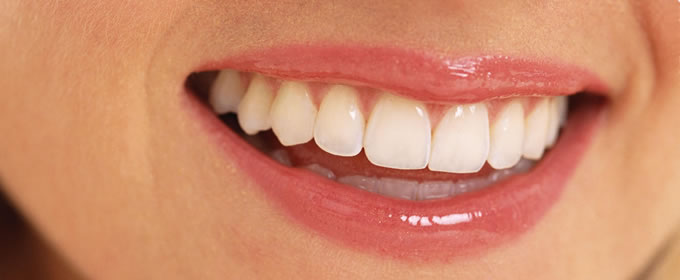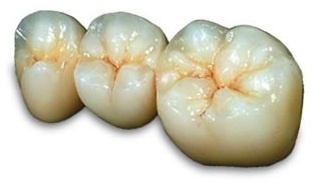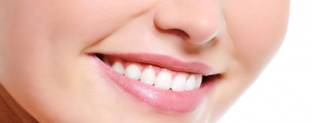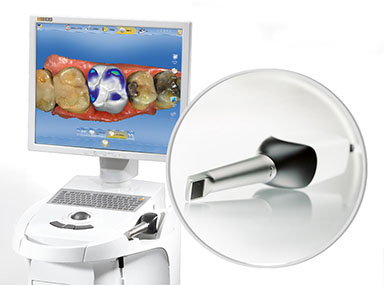The patient can have a new, bright smile in less than a week.

Porcelain Laminate Veneers are wafer-thin shells of porcelain (0.3-0.7mm) which are bonded onto the surfaces of teeth visible during a smile. Because porcelain veneers are wafer-thin, they have highlight transmission capabilities and they reflect the shade of the teeth and composite underneath which provides a natural appearance. The most important advantage of porcelain veneers is that the shapes, shades and positions of the teeth can be rehabilitated in 1 week with 2 sessions.
For the traditional crown and bridge treatments, the enamel tissue that is the protective layer on the tooth surface is completely removed whereas the tiny amount of enamel is removed for the laminates. The amount of the enamel to be removed is determined according to the position of the tooth. For some cases, laminates also can be bonded onto the surfaces of teeth directly without removing any enamel tissue.
The treatment takes a short time. The patient can have a new, bright smile in 5 or 6 days if s/he does not need any periodontal or root canal treatments.
Porcelain laminate veneers can be applied to the patients who are not pleased with the shapes of their teeth and own discolored, spaced, abraded, fractured, filled front teeth.
Porcelain laminate veneers do not debond when they are bonded with the modern adhesives by an experienced dentist. When the laminate veneers are bonded properly and used carefully, they last for 10 to 20 years. In case of chipping of the porcelain (trauma etc.), the veneers can be repaired with the composite filling materials without being removed.
If the patient does not smoke or consume excessive tea or coffee, porcelain laminate veneers do not get discolored because of the material they are made of.
The loss of a tooth that is a part of the facial esthetics causes psychological and social problems as well as nutrition, digestion and also leads to the speech disorders.
Up to the 1980s, gaps caused by the tooth loss were eliminated by the dental bridges. For the application of the dental bridges, the minimum of two teeth adjacent to the gap should be prepared. Today, the artificial roots that are called as "implants" and made of titanium are placed within the bone of the jaws without the need for preparing the adjacent teeth. Porcelain crowns that mimic the function and esthetics of the natural teeth are placed onto the titanium roots.
The patients should be asked whether they have any large organ disease. If there is any, the currnt status of the post treatment should be asked. Treatment is recommended in case of the instable general health. Drug allergy should be questioned. If there is any, choice of the drugs should be done carefully.
Teeth, periodontal status and the bone under the missing tooth should be examined. The dental occlusion is also examined.
They are the fixed or removable dentures prepared to replace the missing teeth until the abutments and the crowns are placed.
After the anesthesia, usually an incision is made over the site and the implant is placed into the socket prepared in the bone. If it is not an flapless treatment, the incision is sutured.
The first week after the implant application is the most important one for the healing. During this period, special mouthwashes should be used. Antibiotics should be used regularly. Ice should be applied to the operation site in the first 24 hours intermittently and extraorally. Extremely hot drinks and solid food should be avoided.
Porcelain crowns should be placed after the healing period of 2 months.
Implants are the artificial roots made of titanium that is biocompatible.
Lifetime of the implant is equal to the lifetime of a natural tooth, depending on the correct diagnosis, planning, implementation and oral hygiene.
The success of the implant application after the periodontal treatment is the same with those without any periodontal disease.
There is not any age limitation for the healthy patients. Implants should be applied to the patients after the puberty period.
Zirconia is a very durable and hard ceramic used as a core material in full ceramic restorations. In today's dentistry, zirconium crowns that combine the features of esthetics and high strength are used frequently and are usually preferred on the front teeth due to their natural appearances.
 Because the underlying metal of the porcelain-to-metal crowns refracts the light, teeth appear to be opaque. The light permeability of the zirconium crowns are as for the natural teeth, so they look like less artificial.
Because the underlying metal of the porcelain-to-metal crowns refracts the light, teeth appear to be opaque. The light permeability of the zirconium crowns are as for the natural teeth, so they look like less artificial.
Porcelain-to-metal crowns can show through as a dark line at the margins of gingiva in time. But especially for the anterior areas where the esthetics is more important, the zirconium crowns look more natural.
 Porcelain-to-metalcrowns are cemented conventionally whereas the zirconium crowns can be cemented mechanically and chemically by the dual-cure cements. Because of the high adhesion capability, fracture or debonding of the crown are prevented.
Porcelain-to-metalcrowns are cemented conventionally whereas the zirconium crowns can be cemented mechanically and chemically by the dual-cure cements. Because of the high adhesion capability, fracture or debonding of the crown are prevented.
Nickel used in metal core of a porcelain-to-metal crown can cause allergic reactions in some patients. But materials used in zirconium crowns are all biocompatible
Teeth Whitening (Dental Bleaching) is the procedure applied to lighten the darkened teeth due to the various reasons. Hydrogen peroxide or carbamide peroxide that are found in bleaching gel provides whitening by reacting with the dental hard tissue (oxidation).
Dental Bleaching is the procedure preferred for the teenagers and the adults. This treatment can be applied to the patients with good oral health, otherwise tooth sensitivity may ocur. That's why the dental bleaching is applied after the caries, abrasions and the peridodontal diseases are treated. The dental bleaching is successful at the patients with the teeth in yellow shade. The amount of whitening is based on the tooth shade before the bleaching is applied and it varies from person to person.
According to the studies, the dental bleaching is safe and effective enough when it is done under a doctor's care. Teeth and gingiva are not damaged at all.
Today, two different bleaching methods are used: One of them is “home-bleaching” which is to be applied at home by the patient. Steps of application:
Dentist takes an impression and prepares the thin plastic application trays.
Bleaching gel is applied to the teeth with the individual trays for the minimum of 0.5-2 hours daily (according to the degree of discoloration).
The treatment is finished in about 1-2 weeks.
The other bleaching method is "Office-bleaching" performed by the dentist.
Steps of the application:
The bleaching gel is applied to the teeth by the experienced dentist.
Also light is applied to the involved teeth for certain time.
Mild and moderate discolorations can be whitened by the special light sources in an hour in the office whereas home bleaching is also needed for the severe ones. Home bleaching can be applied also with a thin penlike brush.
Teeth will always be whiter than before. The first bleaching process will greatly affect the success of the treatment. The other important factors are the consumption of tea, coffee and colorful drinks as well as smoking and the oral hygiene. One or two extra treatments can be needed according to the degree of the discoloration.
This extra treatment does not take such long time. After the dental bleaching, whitening toothpastes and thin penlike whitening brush can be used. These applications extend the life of whitening.
 Gingiva that is one of the most important criteria to ensure an ideal aesthetics during a smile should be considered.
Gingiva that is one of the most important criteria to ensure an ideal aesthetics during a smile should be considered.
The levelling of the excessive gingival display (gummy smile) during a smile, the levelling of the asymmetric gums and the removal of the dark pigments on the gums play major roles in providing "Pink Esthetics".
Excessively visible or asymmetric gums are levelled by periodontal operations or laser therapy. Removal or reduction of dark spots on the gums that is called as "Depigmentation therapy" is possible by lasers.
After the pink aesthetics is obtained, a complete aesthetic integrity can be provided by teeth whitening, porcelain laminates or zirconium crowns.

CAD/CAM stands for "computer-aided design" and "computer-aided manufacturing". In CAD/CAM technology, parts and components used in dentistry are designed and manufactured precisely by a milling device connected to a computer with an integrated software.
Due to the CAD/CAM technology that was introduced in 1988, today, restorations can be done extraorally, in laboratuary or in dental office.
 For a production of a CAD/CAM restoration, the dentist takes a digital photo of the prepared tooth by a small intraoral camera. This digital photo provides 3D information about the adjacent teeth, the defect to be restored and the size of the tooth. Dentist draws the design of the required restoration on the computer screen by using CAD/CAM software. After the required information (restoration type, contours) has been entered, tooth-colored ceramic block or composite material are formed by diamond burs in the milling device for the production of the designed restoration. The restoration removed from the device is tried out intraorally, polished and bonded respectively.
For a production of a CAD/CAM restoration, the dentist takes a digital photo of the prepared tooth by a small intraoral camera. This digital photo provides 3D information about the adjacent teeth, the defect to be restored and the size of the tooth. Dentist draws the design of the required restoration on the computer screen by using CAD/CAM software. After the required information (restoration type, contours) has been entered, tooth-colored ceramic block or composite material are formed by diamond burs in the milling device for the production of the designed restoration. The restoration removed from the device is tried out intraorally, polished and bonded respectively.
 Today, CAD/CAM systems can be used in the production of porcelain or composite inlays, onlays, crowns and laminate veneers. Porcelain or composite CAD/CAM restorations are very durable and esthetic due to their natural appearances. Compared to the conventional restorations that can be placed intraorally after for at least two sessions, CAD/CAM inlays, onlays, laminate veneers and crowns often can be placed in a single session without the need for any impression. Therefore, CAD/CAM restoration is an advantage for patients with nausea reflex during impression taking and who do not have time for a second appointment.
Today, CAD/CAM systems can be used in the production of porcelain or composite inlays, onlays, crowns and laminate veneers. Porcelain or composite CAD/CAM restorations are very durable and esthetic due to their natural appearances. Compared to the conventional restorations that can be placed intraorally after for at least two sessions, CAD/CAM inlays, onlays, laminate veneers and crowns often can be placed in a single session without the need for any impression. Therefore, CAD/CAM restoration is an advantage for patients with nausea reflex during impression taking and who do not have time for a second appointment.